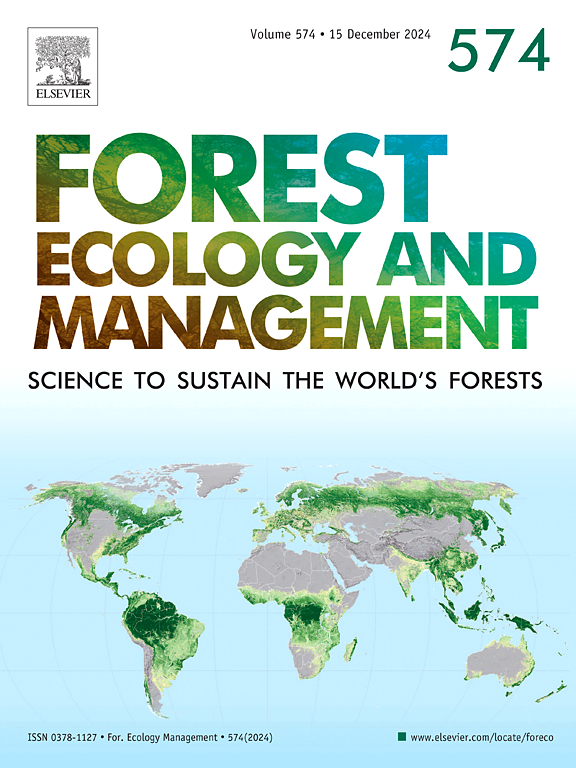植树造林中的可持续木材生产:巴塔哥尼亚西北部提供多种生态系统服务的权衡与协同作用
IF 3.7
2区 农林科学
Q1 FORESTRY
引用次数: 0
摘要
评估松树种植园的生态系统服务(ES)需要全面分析这些受管理的生态系统所带来的各种益处和弊端。此类评估通常特别考虑提供、调节和支持服务,但往往忽略了生物多样性丧失、土壤碳平衡和土地使用冲突等重要问题。了解不同密度、年龄和结构的人工林的这些动态变化对于可持续森林管理至关重要。我们的目标是通过间接量化阿根廷巴塔哥尼亚北部干旱草原环境中松柏人工林的几种生态系统,分析生态系统权衡和协同作用的变化。我们评估了不同造林管理下人工林的土壤肥力保持、水土流失预防、饲料生产、木柴生产和木材生产以及周围自然栖息地的变化情况。我们发现,在安第斯巴塔哥尼亚北部地区,木材产量的增加会减少饲料和木柴产量,而饲料和木柴是安第斯巴塔哥尼亚北部地区两种重要的土地利用方式,因此在提供服务的指标之间存在明显的权衡。有趣的是,我们在支持性服务或调节性服务方面没有观察到这种权衡,因为土壤肥力保持和水土流失预防指标保持稳定,没有显著下降;在中等种植密度和基底面积条件下发现了更高的数值。这表明,它们在空间上的出现不会对土壤养分动态或防止侵蚀的潜力产生负面影响。相反,低密度、年轻和稀疏的人工林有利于与其他土地用途(如饲料和木柴)共存。因此,将不同树龄和管理方法的人工林结合在一起的战略性景观规划,有可能最大限度地提供这三种服务。本文章由计算机程序翻译,如有差异,请以英文原文为准。
Sustainable timber production in afforestations: Trade-offs and synergies in the provision of multiple ecosystem services in northwest Patagonia
Evaluating ecosystem services (ES) in pine plantations involves a comprehensive analysis of the diverse benefits and drawbacks that these managed ecosystems offer. Such assessments typically consider particularly provisioning, regulating, and supporting services, yet they often overlook important concerns such as biodiversity loss, soil carbon balance, and land-use conflicts. Understanding these dynamics in plantations with different density, age and structure is crucial for sustainable forest management. Our objective was to analyze changes in ES trade-offs and synergies by indirectly quantifying several ES in Pinus ponderosa plantations in a xeric grassland environment in northern Patagonia, Argentina. We assessed changes in soil fertility maintenance, erosion prevention, forage production, firewood production, and timber production across plantation stands under a diverse range of silvicultural managements and the surrounding natural habitat. We found a clear trade-off between indicators of provision services, as increasing timber production diminishes forage and firewood production —two vital land uses in the northern region of Andean Patagonia. Interestingly, we did not observe such trade-offs in supporting services or regulating services, as indicators of soil fertility maintenance and erosion prevention remained stable, without significant declines; higher values were found in intermediate plantation densities and basal area conditions. This suggests that their spatial occurrence does not negatively impact soil nutrient dynamics or the potential for erosion prevention. Conversely, low-density, young, and thinned plantations facilitate coexistence with other land uses such as forage and firewood. Therefore, a strategically planned landscape, incorporating plantations of varying ages and management practices, offers the potential for maximizing all three provision services.
求助全文
通过发布文献求助,成功后即可免费获取论文全文。
去求助
来源期刊

Forest Ecology and Management
农林科学-林学
CiteScore
7.50
自引率
10.80%
发文量
665
审稿时长
39 days
期刊介绍:
Forest Ecology and Management publishes scientific articles linking forest ecology with forest management, focusing on the application of biological, ecological and social knowledge to the management and conservation of plantations and natural forests. The scope of the journal includes all forest ecosystems of the world.
A peer-review process ensures the quality and international interest of the manuscripts accepted for publication. The journal encourages communication between scientists in disparate fields who share a common interest in ecology and forest management, bridging the gap between research workers and forest managers.
We encourage submission of papers that will have the strongest interest and value to the Journal''s international readership. Some key features of papers with strong interest include:
1. Clear connections between the ecology and management of forests;
2. Novel ideas or approaches to important challenges in forest ecology and management;
3. Studies that address a population of interest beyond the scale of single research sites, Three key points in the design of forest experiments, Forest Ecology and Management 255 (2008) 2022-2023);
4. Review Articles on timely, important topics. Authors are welcome to contact one of the editors to discuss the suitability of a potential review manuscript.
The Journal encourages proposals for special issues examining important areas of forest ecology and management. Potential guest editors should contact any of the Editors to begin discussions about topics, potential papers, and other details.
 求助内容:
求助内容: 应助结果提醒方式:
应助结果提醒方式:


